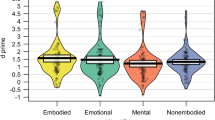Abstract
Enzymes are remarkable molecules which make metabolism possible. Their processing powers are considerable for not only are they catalysts they also contribute to information processing, integration, coherence and memory in the cell. This complex of attributes suggests that a complementary perspective to enzyme nature and activity is needed related to what enzymes and verbs have in common. The value of this kind of thinking is that it shifts the focus from objects and mechanisms to processes and information. In order to support this idea a number of features which enzymes and verbs share are discussed including, context-dependence, occurrence, cases, voice, mood and glue/integrative capacities. The paper concludes with some reflections on the utility of a view of enzymes as verbs.
Similar content being viewed by others
REFERENCES
Alberts, B., D. Bray, J. Lewis, M. Raff, K. Roberts, and J.D. Watson (1993). Molecular Biology of the Cell. New York, Garland Publishing.
Albrecht-Buehler, G. (1990). In Defense of 'nonmolecular' biology. International Review of Cytology 120: 191–241.
Bray, D. (1995). Protein molecules as computational elements in living cells. Nature 376: 307–312.
Conrad, M. (1992). The seed germination model of enzyme catalysis. BioSystems 27: 223–233.
Ehresmann, A.C., and J.-P. Vanbremeersch (1987). Hierarchical evolutive systems: A mathematical model for complex systems. Bull. Math. Biol. 49: 13–50.
Fellbaum, C. (1990). English verbs as a semantic net. International Journal of Lexicography 3: 278–301.
Fillmore, C.J. (1968). The case for case. In: E. Bach, and R.T. Harms, eds., Universals in Linguistic Theory, 1–88. New York, Holt, Rinehart & Winston.
Kelly, K. (1994). Out of Control The New Biology of Machines. London, Fourth Estate.
Klinman, J.P. (1989). Quantum mechanical effects in enzyme-catalysed hydrogen transfer reactions. Trends in Biochemical Sciences 14: 368–373.
Markman, E.M., M.S. Horton, and A.G. McLanahan (1980). Classes and collections: principles of organisation in the learning of hierarchical relations. Cognition 8: 227–241.
Matsuno, K. (1989). Protobiology: Physical Basis of Biology. Boca Raton, FL, CRC Press.
Miller, G.A., and C. Fellbaum (1991). Semantic networks in English. Cognition 41: 197–229.
Ovàdi J., and P.A. Srere (1996). Metabolic consequences of enzyme interactions. Cell Biochem. & Function 14: 249–258.
Paton, R.C. (1992). Towards a metaphorical biology. Biology & Philosophy 7: 279–294.
Paton, R.C. (1993). Some computational models at the cellular level. BioSystems 29: 63–75.
Paton, R.C. (1997). Glue, verb and text metaphors in biology. Acta Biotheoretica 45: 1–15.
Paton, R.C., H.S. Nwana, M.J.R. Shave, and T.J.M. Bench-Capon (1994). An examination of some metaphorical contexts in biologically motivated computing. British Journal for the Philosophy of Science 45: 505–525.
Paton, R.C., G. Staniford, and G. Kendall (1996). Specifying logical agents in cellular hierarchies. In: R. Cuthbertson, M. Holcombe, and R. Paton, eds., Computation in Cellular and Molecular Biological Systems. Singapore, World Scientific.
Paton, R.C., and K. Matsuno (1997). Verbs, glue and categories in the cellular economy. Proceedings of IPCAT 97 Conference, University of Sheffield, September.
Pilkis, S.J., T.H. Claus, I.J. Kurland, and A.J. Lange (1995). 6-Phosphofructo-2-kinase/fructose-2,6-bisphosphatase: A metabolic signalling enzyme. Annu. Rev. Biochem. 64: 799–835.
Roche, J. (1990). New tasks for the philosophy of physics. In: R. Bhaskar, ed., Harré and His Critics, pp. 89–111. Oxford, Blackwell.
Rosen, R. (1991). Life Itself. New York, Columbia University Press.
Srere, P. A. (1994). Why are enzymes so big?-TIBS 9: 387–390.
Uyeda, K. (1992). Interactions of glycolytic enzymes with cell membrane. Current Topics in Cell. Reg 33: 31–46.
Welch, G.R. (1992). An analogical field construct in cellular biophysics: history and present status. Prog. Biophys. molec. Biol. 57: 71–128.
Welch, G.R. (1994). The computational machinery of the living cell. In: R.C. Paton, ed., Computing with Biological Metaphors, Chapter 4. London, Chapman and Hall
Welch, G.R., and D.B. Kell (1986). Not just catalysts — molecular machines in bioenergetics. In: G.R. Welch, ed., The Fluctuating Enzyme, pp451–492. New York, John Wiley.
Wilson, J.E. (1980). Brain hexokinase, the prototype ambiquitous enzyme. Current Topics in Cellular Regulation 16: 1–54.
Author information
Authors and Affiliations
Rights and permissions
About this article
Cite this article
Paton, R., Matsuno, K. Some Common Themes for Enzymes and Verbs. Acta Biotheor 46, 131–140 (1998). https://doi.org/10.1023/A:1001125803556
Issue Date:
DOI: https://doi.org/10.1023/A:1001125803556



